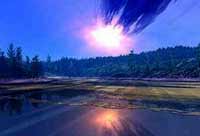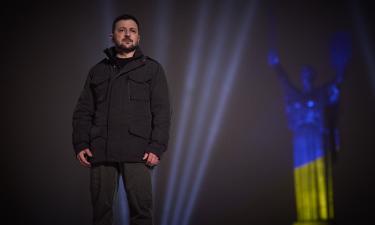Tunguska explosion still unraveled 100 years after
The mystery, which took place 100 years ago, on June 30, 1908, not far from the Tunguska River in Russia’s Siberia, still remains unraveled. Many compare the power of the Tunguska catastrophe with the nuclear explosion of Hiroshima and Nagasaki, although there were not so many casualties, since the meteorite or whatever it was fell down in the uninhabited area.

Science has not been able to explain the mysterious Tunguska phenomenon yet. Scientists and pseudo-scientists consider several versions which include antimatter, a miniature black hole and even an alien spaceship.
First researchers appeared on the site of the Tunguska disaster in more than ten years after the event occurred. Regular studies were launched only in the 1920s. Eyewitnesses told researchers that they had seen a huge pillar of fire in the sky and could feel the earthquake. The people living very far from the site of the catastrophe said that they could feel the heat in the air.
In 1930, astrophysicist Harlow Shapley found the biggest problem, which deprived scientists of sleep for decades: there was no crater on the site where the space body supposedly hit the Earth. The scientist put forward another version in an attempt to explain the mystery. Shapley believed that the Tunguska meteorite was not a meteorite but a comet or its fragments.
In 1940, Vladimir Royansky from the US-based Union College in Schenectady presumed that the Tunguska meteorite was made of antimatter. In 1941, Lincoln La Paz from the Ohio University in Columbus published two articles on this subject in Popular Astronomy magazine and substantiated the hypothesis. Afterwards, he sent a letter to the Academy of Sciences of the USSR suggesting to search for anomalous isotopes on the site of the impact to prove the presence of antimatter.
The idea was developed further by three prominent US scientists with Nobel Prize winners Willard Libby and Clyde Cowan (a discoverer of the neutrino) among them. Libby, the creator of the renowned radiocarbon dating (a process which revolutionized archeology), concluded that the space body of antimatter had not reached the Earth, but annihilated as a result of entering dense layers of the Earth’s atmosphere. However, gamma-ray detectors installed on first artificial satellites did not show any incidents of antimatter annihilation in near space.
In 1973, two physicists from the University of Texas presumed that the Tunguska meteorite was a miniature black hole which went through the Earth. Physicist Stephen Hawking believed that miniature black holes appeared after the Big Bang. However, there was no information about the miniature black home coming out of the planet at another end of the globe and thus producing an explosion similar to the Tunguska disaster.
There is also a simple version to explain the Tunguska mystery. It was said that the disaster was caused with an earthquake which triggered the discharged and the subsequent explosion of a huge amount of natural gas – up to ten million tons. In this case gas could form the pillar of fire rising up to the sky and spread a massive wave of heat.
Chris Chyba, Kevin Zahnle and Paul Thomas unraveled the biggest mystery of the Tunguska meteorite in 1993. With the help of computer models they showed that the meteorite exploded in the atmosphere into thousands of fragments and thus left no crater on the site of the impact.
Various UFO aficionados have claimed that the Tunguska event was the result of an exploding alien spaceship or even an alien weapon going off to "save the Earth from an imminent threat". These claims appear to originate from a science fiction story penned by Soviet engineer Alexander Kazantsev in 1946, in which a nuclear-powered Martian spaceship, seeking fresh water from Lake Baikal, blew up in mid-air. This story was inspired by Kazantsev's visit to Hiroshima in late 1945.
Many events in Kazantsev's tale were subsequently confused with the actual occurrences at Tunguska. The nuclear-powered UFO hypothesis was adopted by TV drama critics Thomas Atkins and John Baxter in their book The Fire Came By (1976). The 1998 television series The Secret KGB UFO Files (Phenomenon: The Lost Archives), broadcast on Turner Network Television, referred to the Tunguska event as "the Russian Roswell" and claimed that crashed UFO debris had been recovered from the site. In 2004, a group from the Tunguska Space Phenomenon Public State Fund claimed to have found the wreckage of an alien spacecraft at the site.
The proponents of the UFO hypothesis have never been able to provide any significant evidence for their claims. It should be noted that the Tunguska site is downrange from the Baikonur Cosmodrome and has been contaminated repeatedly by Russian space debris, most notably by the failed launch of the fifth Vostok test flight on December 22, 1960. The payload landed close to the Tunguska impact site, and a team of engineers was dispatched there to recover the capsule and its two canine passengers (who survived).
Subscribe to Pravda.Ru Telegram channel, Facebook, RSS!





